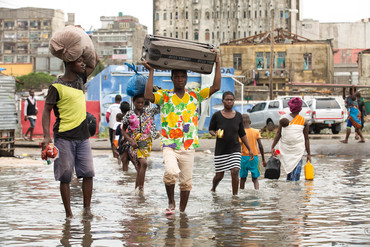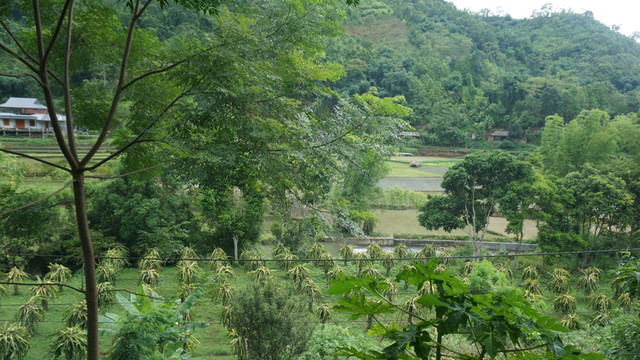Climate change is pushing the poorest countries further into debt. Can insurance fix it?
Parametric insurance can get immediate pay-outs to countries hit by climate disasters − speeding along recovery and avoiding risks of deeper debt traps.


Mozambique after Cyclone Idai. Mozambique is one of the countries that is most at risk of increasing their debt due to their exposure to climate hazards, according to the study (Photo: Denis Onyodi/IFRC/DRK/Climate Centre, via Flickr, CC BY-NC 2.0)
In the last couple of weeks, my hometown in the Indian state of Maharashtra has been hit by the worst heatwave I can remember. Thirteen people died of heatstroke just by attending a government award ceremony in the open air.
Last month I was working in Bangladesh where on the island of Urir Char, every household has had to move at least three times, and sometimes up to seven times, due to sea level rises and cyclones.
Each time, they lose their home, agricultural land and livelihoods, making them economically poor and socially marginalised. Successive losses mean they have to use savings to make ends meet or borrow money from local money lenders. When they are not able to pay back the money, they are forced into debt bondage. Our research shows that 42% of those migrating due to climate distress are exposed to the risk of trafficking and slavery.
Deeper into debt
This situation is no different for many low-income countries, where the impacts of climate change are accelerating a debt crisis. Every time a disaster strikes, the least developed countries (LDCs) and Small Island Developing States (SIDS) have to take on additional loans on top of pre-existing debt to bring their economies back on track, provide urgent relief, help communities return to some level of normality and restart their economic activities.
As the intensity and frequency of extreme weather events keeps increasing, they are more exposed every year. Each time, their response creates more debt, undermining their capacity to deal with the next crisis.
And so they become trapped in an unsustainable debt cycle.
In Vanuatu, back in 2013, overall debt was 20% of GDP. After the country was hit by a series of cyclones, debt increased to 36.5% of GDP in 2015 and 44% in 2018. In March this year, they were again hit by a pair of intense tropical cyclones, Judy and Kevin, within 48 hours of each other, the impacts of which are yet to be estimated.
Our analysis of 30 least developed countries shows that if their exposure to climate hazards is almost doubled, their chances of defaulting on debt will increase by over 1,000% and it would be countries like Niger, Myanmar, Sudan, Mozambique and Mali that would be most at risk.
These rising debt levels have other consequences for poorer countries. During climate disasters, while government’s revenue and tax collections go down due to the disruption in economic activities, they have to continue servicing the debt.
They are forced to reduce spending on poverty reduction, food aid, health and so on. Reduction in social spending and rising costs can lead to protests, civil unrest and even regime change, as citizens lose faith in their government’s ability to manage the economy.
Sri Lanka and Pakistan are recent examples of this phenomenon. Eleven people were killed in at food distribution centre in Pakistan due to stampede and Sri Lanka saw tens of thousands of protesters storming the president’s home in a display of anger over the country's economic crisis.
Poorer countries need protection. Parametric insurance cover for countries’ debt could be one of the options for resolving the debt crisis.
Automatic pay-outs
Parametric insurance is different from traditional insurance which only pays out once losses have been verified. With parametric insurance, the pay-out is based on certain pre-agreed trigger events such as flood, cyclones or droughts of a certain intensity or frequency.
Under the proposed model, the insurance would cover debt repayment on behalf of the country during the period of climate crisis, giving them time to recover, without worrying about servicing their debt during that period. This would go far beyond the kind of debt pause or deferment offered under some relief mechanisms, where the debt remains to be paid off at a later time.
Here, debt repayment would continue as normal through the insurance mechanism, allowing countries to focus on relief and recovery. It could act as a safeguarding mechanism against droughts, floods and other shocks that require emergency borrowing, free up a country’s resources that would otherwise be used to repay debts.
It would also help stabilise credit markets and improve the credit rating of countries by averting a debt crisis, enabling them to borrow money at lower cost in future.
A global fund that pools climate finance
Such a model would require the creation of a global fund, pooling in climate and other debt relief funds from the World Bank and International Monetary Fund (IMF) to cover insurance premiums for low-income countries. The global fund could make insurance affordable by pooling the risks, where insurance premiums would be reduced on the premise that not all countries in the pool would be faced with climate crisis at the same time.
What we need now is a coordinated effort with support from G20 governments, other major developed countries, IMF and the World Bank to make such insurance for sovereign debt a reality.





